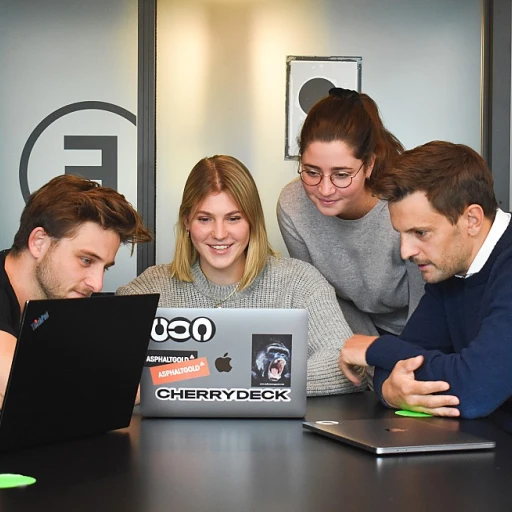
Understanding the Role of Instructional Design in Employee Retention
Leveraging Instructional Design for Sustainable Workforce
In today's fast-paced corporate environment, the role of instructional design is pivotal in enhancing employee retention. Instructional design sheds light on the essential connection between effective training programs and the commitment employees hold towards their organizations. Companies that invest in robust learning solutions tend to see a decrease in staff turnover, realizing that employee well-being and satisfaction majored through learning development. Effective instructional design involves a comprehensive approach that is considerate of both the company's mission and the staff's personal growth. This dual focus ensures that training content is not only relevant to the job role but also assists employees' career advancement, effectively aligning individual aspirations with corporate goals. A meticulous design service from adept instructional designers can be a transformative force within any organization, providing custom learning paths that pique employees' interest and propel them towards achieving both company and personal objectives. Furthermore, instructional design services offer a range of learning solutions, from traditional instructor led training to innovative eLearning platforms. By integrating technology in course design and learning experiences, organizations can foster an engaging and interactive atmosphere that promotes continuous professional development. Instructional designers use data-driven insights to tailor content that resonates with employees' individual learning styles and preferences, ensuring long-term retention and satisfaction.Aligning Learning Objectives with Organizational Goals
Integrating Learning Goals with Business Objectives
Incorporating instructional design effectively requires aligning learning objectives with the overall goals of an organization. This strategic alignment supports employee retention by ensuring that training programs are not only relevant but also valuable to both employees and the business as a whole. Firstly, by clarifying the business objectives, instructional designers can tailor course design to support these specific targets. Whether it’s improving team productivity, enhancing customer service, or developing leadership skills, knowing the business’s core goals helps in crafting instructional content that resonates with employees’ roles and career aspirations. Moreover, developing a training program that reflects the organization's mission and values fosters a sense of belonging among employees. This sense of alignment can enhance job satisfaction and motivation, which are critical factors in retaining talent. For example, custom learning solutions can be crafted to meet the specific needs of a business, considering the skills and competencies that need honing. This not only makes the learning more impactful but also helps in crafting a career development path for employees. As employees see clear connections between their training and personal career growth, their engagement and retention levels are likely to increase. Working alongside a design consulting team or hiring a design consultant can further aid in weaving these learning objectives seamlessly with business goals. Instructional designers equipped with industry knowledge can provide learning development strategies that not only address current challenges but also anticipate future workforce needs. By offering tailored experiences, such as online and elearning courses, organizations can keep the training flexible and accessible, meeting varied learning preferences and schedules. This level of customization and alignment can significantly enhance the value proposition for employees, ultimately supporting higher retention rates. For those interested in exploring these strategies further, exploring Cobalt Corporate Learning Solutions can provide deeper insights into how custom solutions can transform employee development and retention.Creating Personalized Learning Paths
Crafting Tailored Learning Pathways for Employee Success
In the realm of employee development, creating personalized learning paths is a pivotal strategy for enhancing retention. Recognizing the diverse needs and capabilities of each employee, instructional designers have the opportunity to design custom learning experiences that align with both individual growth and organizational success. Through the strategic use of design services, organizations can develop tailored training programs that address unique learner profiles and foster long-term engagement.
Personalizing learning involves more than just creating generic content. Instructional designers must consider the specific goals, skills, and interests of each employee to ensure that the learning solutions provided are both relevant and effective. By employing an array of instructional design techniques, designers can build custom learning experiences that resonate with employees on a personal level.
Technology plays a crucial role in facilitating personalized learning paths. With the aid of eLearning platforms and online modules, organizations can offer flexible learning solutions that cater to individual schedules and preferences. This approach allows for the integration of various training formats, such as instructor-led sessions or self-paced online courses, providing a more comprehensive learning experience. Employees can navigate their development pathways at their own pace, ensuring that they acquire the necessary knowledge and skills without feeling overwhelmed or disengaged.
Offering learning paths customized to the needs of the workforce not only enhances employee satisfaction but also drives productivity and retention. As employees perceive that their growth is valued and supported, they are more likely to remain loyal to the organization. Instructional designers and design consultants play a key role in this process, collaborating with organizational leaders to implement effective training solutions that meet both the learners' needs and the business objectives.
For organizations looking to enhance their employee retention strategies through customized training, exploring diverse learning solutions can provide substantial benefits. By designing courses that are tailored to individual learning styles, content becomes more engaging, impactful, and ultimately contributes to a more committed and motivated workforce. To learn more about how diversity, equity, and inclusion can complement coaching and employee retention, check out this insightful article.
Utilizing Technology to Enhance Learning Experiences
Leveraging Technology to Foster Dynamic Learning
The integration of technology in instructional design has revolutionized the way employee training and development are approached. In today's fast-paced corporate environment, leveraging online platforms and eLearning solutions is crucial in crafting effective and engaging learning experiences. Using a blend of traditional and digital methods, organizations are now able to offer custom learning solutions tailored to meet the specific needs of their teams. Instructional designers are increasingly utilizing technology to develop courses that not only transfer knowledge but also engage employees in an interactive manner. This dual approach has proven invaluable in enhancing the overall training program.- eLearning Platforms: These platforms provide the flexibility for employees to learn at their own pace and on their own schedule, making the learning process more personalized and accessible. Online training courses often include multimedia content, quizzes, and interactive modules, which can improve retention and understanding of complex concepts.
- Instructor-Led Training: While eLearning is a powerful tool, instructor-led sessions continue to play a pivotal role in the corporate training landscape. These sessions, supported by digital tools, ensure that employees can interact with instructors, ask questions, and participate in discussions, thereby building a robust learning environment.
- Learning Management Systems (LMS): An LMS is instrumental in tracking progress, identifying skill gaps, and customizing learning paths for employees. It allows instructional designers to offer targeted content and monitor the effectiveness of training sessions.
Measuring the Impact of Instructional Design on Retention
Evaluating the Effectiveness of Instructional Design
To truly understand the impact of instructional design on employee retention, it's crucial to measure its effectiveness. This involves assessing how well the instructional design services align with the organization's learning objectives and goals. By doing so, companies can ensure that their training programs are not only engaging but also contribute to the overall development of their employees.
Key Metrics for Measuring Success
When evaluating the success of instructional design, several key metrics can be considered:
- Employee Engagement: Are employees actively participating in the training programs? High engagement levels often indicate that the learning content is relevant and well-designed.
- Knowledge Retention: Post-training assessments can help determine how much information employees retain over time. This is a direct indicator of the effectiveness of the instructional content.
- Performance Improvement: Monitoring changes in employee performance post-training can provide insights into the practical application of the skills learned.
- Feedback and Satisfaction: Gathering feedback from participants about their learning experiences can highlight areas for improvement and success.
Leveraging Technology for Data Collection
Utilizing technology is essential in collecting and analyzing data related to instructional design. Learning management systems (LMS) and other eLearning platforms offer tools to track progress, completion rates, and assessment scores. These platforms can provide valuable insights into how well the instructional design services are meeting the learning objectives and contributing to employee retention.
Continuous Improvement through Feedback
Feedback from employees is invaluable in refining instructional design. Instructional designers and design consultants can use this feedback to make necessary adjustments to the course design, ensuring that the training remains relevant and effective. This iterative process helps in creating custom learning solutions that are tailored to the needs of the organization and its employees.
By systematically measuring the impact of instructional design, organizations can make informed decisions about their training programs, ultimately enhancing employee retention and satisfaction.
Case Studies: Success Stories in Instructional Design and Retention
Real-World Examples of Instructional Design Success
Instructional design services have proven to be a cornerstone in enhancing employee retention across various industries. By aligning learning objectives with organizational goals, companies have seen a marked improvement in employee engagement and retention rates. Here are some real-world examples that highlight the effectiveness of instructional design in corporate training and development.
Technology Firm Boosts Retention with Custom Learning Solutions
A leading technology firm faced challenges with high turnover rates among its software development team. By employing instructional designers to create custom learning paths, the company was able to tailor training programs to meet the specific needs of its employees. This approach not only improved the learning experience but also increased job satisfaction, resulting in a 20% reduction in turnover within a year.
Healthcare Provider Enhances Training with eLearning
A major healthcare provider implemented an eLearning platform to deliver instructor-led training and online courses. The instructional design team focused on creating engaging content that was both informative and accessible. By utilizing technology to enhance learning experiences, the organization saw a significant improvement in knowledge retention and employee performance, leading to better patient care and increased employee retention.
Retail Chain Sees Success with Personalized Training Programs
In the retail sector, a national chain sought to improve its employee retention rates by developing personalized training programs. Instructional designers worked closely with the HR team to align learning objectives with the company's strategic goals. The result was a series of effective training programs that catered to the diverse needs of the workforce, ultimately leading to higher retention rates and improved customer service.
Financial Institution Leverages Design Consulting for Effective Training
A financial institution partnered with a design consulting firm to revamp its corporate training programs. By focusing on creating engaging and relevant course content, the instructional design services provided helped the organization achieve its learning development goals. The project led to a more knowledgeable workforce and a noticeable decrease in employee turnover.
These case studies demonstrate the power of instructional design in creating effective learning solutions that not only enhance employee skills but also contribute significantly to retention efforts. By investing in well-designed training programs, organizations can foster a more committed and satisfied workforce.












